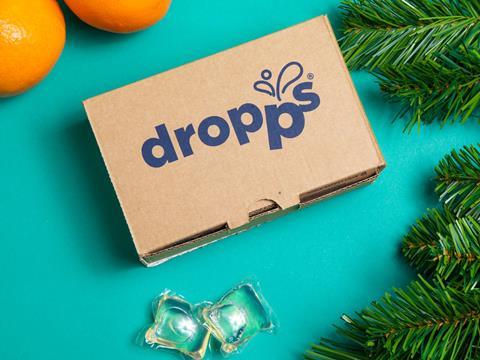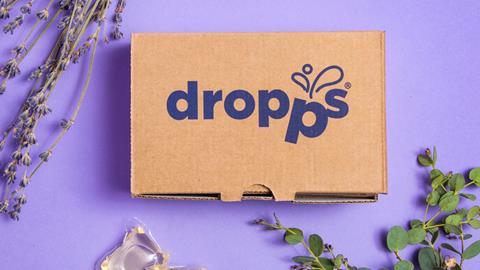It's safe to say that the single-unit dose laundry detergent pod has become a ubiquitous product on shop shelves across the world. But, who can take the credit for inventing it? One company, Dropps, claims this title - and its business model is arguably as innovative as the product that it became known for.
Fin Slater spoke with the company's CEO and founder, Jonathan Propper, about investment, sustainability, and its unique business-to-consumer model.
Dropps just secured its first external investment - $16 million from London-based "ANTI-VC" firm, The Craftory. Could you give us a bit of background on this and explain its significance for your company?
Well first and foremost, The Craftory is not just another venture capital fund. They consider themselves an “Anti-VC” firm, as they provide permanent capital to mission-driven brands that have the greater good in mind, including both society and the planet. They encourage slow, sustainable growth which is unheard of for the average VC firm; especially when it comes to direct-to-consumer companies like ours.
The mission of The Craftory aligns flawlessly with Dropps: we both believe that sustainability and affordability don’t have to be mutually exclusive. The co-founders of The Craftory, Elio Leoni Sceti and Ernesto Schmitt, are veterans of the consumer-packaged goods industry, and know exactly what it takes to set us up for a future where sustainability is more than just a trend, but part of everyday life that is accessible to the masses. In fact, TheCraftory only invests in CPG brands, which speaks further to their expertise in the field and our willingness to partner with them.
For our readers who might be unaware, could you explain Dropps’ flagship product?
Our flagship product by far has to be our laundry detergent pods. In fact, we’re credited with inventing the single-unit dose laundry detergent pod four years before “big laundry” entered into the category. We figured: “Why ship big bottles of water around the country? There’s water already in the machine - why not remove it from the detergent entirely?”
We noticed the unit dose concept being used in another industry and adapted the technology to create the very first liquid unit dose laundry detergent pod. When Dropps laundry detergent pods were first developed, it was important for us to eliminate all the unnecessary additives, fillers and water to create the most efficient pod product which results in a major cost and emissions savings for both our company and the consumer.
Dropps laundry detergent pods weigh in at just 10g and feature a single layer of dissolvable film. In comparison, other competitors in the space weigh in at 25g+ with multi-chamber products that are full of water, unnecessary additives, and colorants. Other brands use multiple colored chambers as a marketing tactic. At Dropps, we believe that color doesn’t clean - there’s no reason to include these ingredients used solely for marketing purposes.
Dropps pods are described as “biodegradable” – can you tell us about how your pods break down, as well as which LCAs/certifications Dropps has used to prove this?
Absolutely. We measure up to some tough standards to make sure we remain convenient but with a conscience. Our pods are composed using a water-soluble film membrane made from poly-vinyl alcohol (PVOH). When the film dissolves in your washer and enters the water stream, microorganisms (including bacteria, yeasts, and fungi) that commonly exist in water treatment plants are capable of breaking down polyvinyl alcohol to water and carbon dioxide.
Though we currently do not have LCA’s on our products at this time, we have reformulated and developed new product lines with the EPA’s CleanGredients ingredient database as a guiding resource. CleanGredients is the definitive marketplace for chemical ingredients whose formulations have been pre-approved by the U.S. EPA for use in Safer Choice-labeled products.
Dropps was awarded the EPA Safer ChoicePartner of the Year title by the U.S. Environmental Protection Agency (EPA) for outstanding achievement in the formulation and product manufacturing of both consumer and institutional/industrial products. Dropps also qualifies for the Safer Choice label by meeting the EPA’s Safer Choice Standard, which includes stringent human and environmental health criteria.
.jpg)
From what I’ve seen, Dropps come packaged in cardboard. If, for example, there was a leakage during transit, might this packaging medium become compromised in a way that plastic might not, thus leading to wastage – especially considering its contents? So, while some forms of plastic may have their downsides, is there a sense that replacing them with other materials, as Dropps is doing, could lead to unintended consequences?
Our packaging engineers determined the best configuration to manage variables like cube utilization, carton size, compression strength, stacking and stability to prevent damage (and leakage) from occurring in-transit. Traditional liquid laundry detergents and other household cleaning products are relatively heavy, as they can contain up to 75% water, and require heavy-duty containers to avoid leaking in-transit. They are usually packaged in HDPE (high-density polyethylene) plastic bottles. 68% of these bottles are not recycled and experts contend that there are up to 5.25 trillion pieces of plastic weighing up to 660 billion pounds floating in our oceans and waterways. By choosing Dropps, consumers have prevented over 1 million single-use plastic bottles, jugs, and containers from entering and polluting our oceans and waterways.
Dropps sells direct to consumer – what are the benefits and challenges of this model?
A major benefit to operating via the direct-to-consumer model is sustainability, which again, is a core pillar to our brand. The traditional retail model is quite wasteful. During the infancy of Dropps, we did partner with several third-party retailers, but quickly noticed that the complexities involved, especially with logistics, did not speak to our eco-responsible ethos. Traditional liquid laundry detergents have long been known as “the most expensive water to ship” thanks to the unnecessary additives in its formulas and bulky plastic packaging. By shipping direct-to-consumer, we’ve effectively eliminated the middleman, including their wasteful overhead.
The traditional retail model did offer various touchpoints for our brand, but even then, the hierarchies and politics of shelf-space at the big box retailers did not yield as big of a return as we experienced once we shifted our focus to a digital-first business. When supportive marketing strategies were applied (including the debut of our now iconic Naked Truth commercial ), we were able to effectively garner the attention of our targeted markets without having to answer to the big box retailers.
Not to mention that with the direct-to-consumer business model, we now have a direct line of communication with our customers, and we can now apply their feedback to inform our business operations including product development, packaging, and other elements.
Dropps was apparently in the laundry pod market before bigger players like Tide and Ariel. Now that the market has grown, what separates Dropps from its numerous competitors?
We pride ourselves on offering a safer, more sustainable clean than our competitors. While the leading laundry detergents have on average 26 ingredients, Dropps bestselling sensitive-skin unscented formula has on average 6 ingredients and still performs as well as the leading brands in cleaning efficacy, minus all the unnecessary additives.

Over the past year, we have successfully achieved carbon-neutral status, and we now offer free carbon-neutral shipping on all products, a benefit not seen across the market with our competitors. As the market has grown, we noticed our competitors prioritize either affordability or sustainability.
Dropps, on the other hand, believes that the consumer can have it all: safe, effective, and eco-responsible products that are both convenient and economical. Not one thing at the expense of another. It is our goal to design products that allow us to offer better alternatives - both from a formulation and packaging standpoint.
What can we expect from Dropps in the next five years?
With the investment from The Craftory, we plan to grow our staff and expand our infrastructure, in order to continue to offer the most sustainable home essential goods around. This next chapter in our company history requires innovative thinking and new-age solutions to ensure we are at the forefront of our society’s inevitable sustainable and renewable future.
We intend to enter into new product categories and possibly even new markets, as our customer base grows over the years.
















